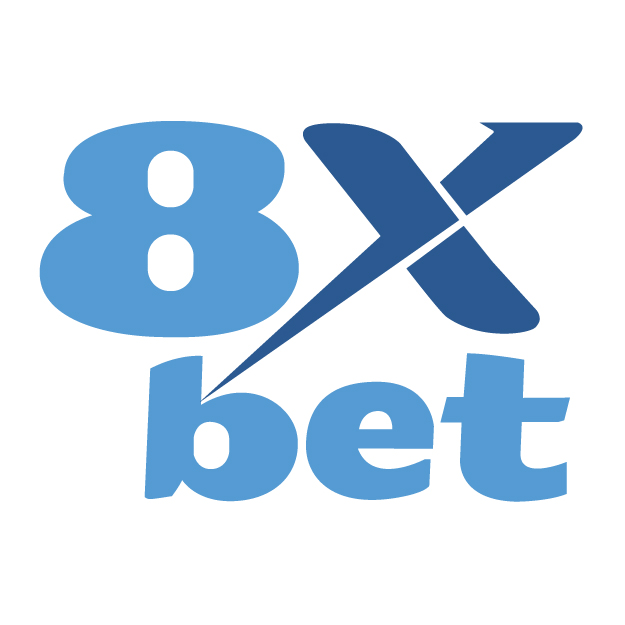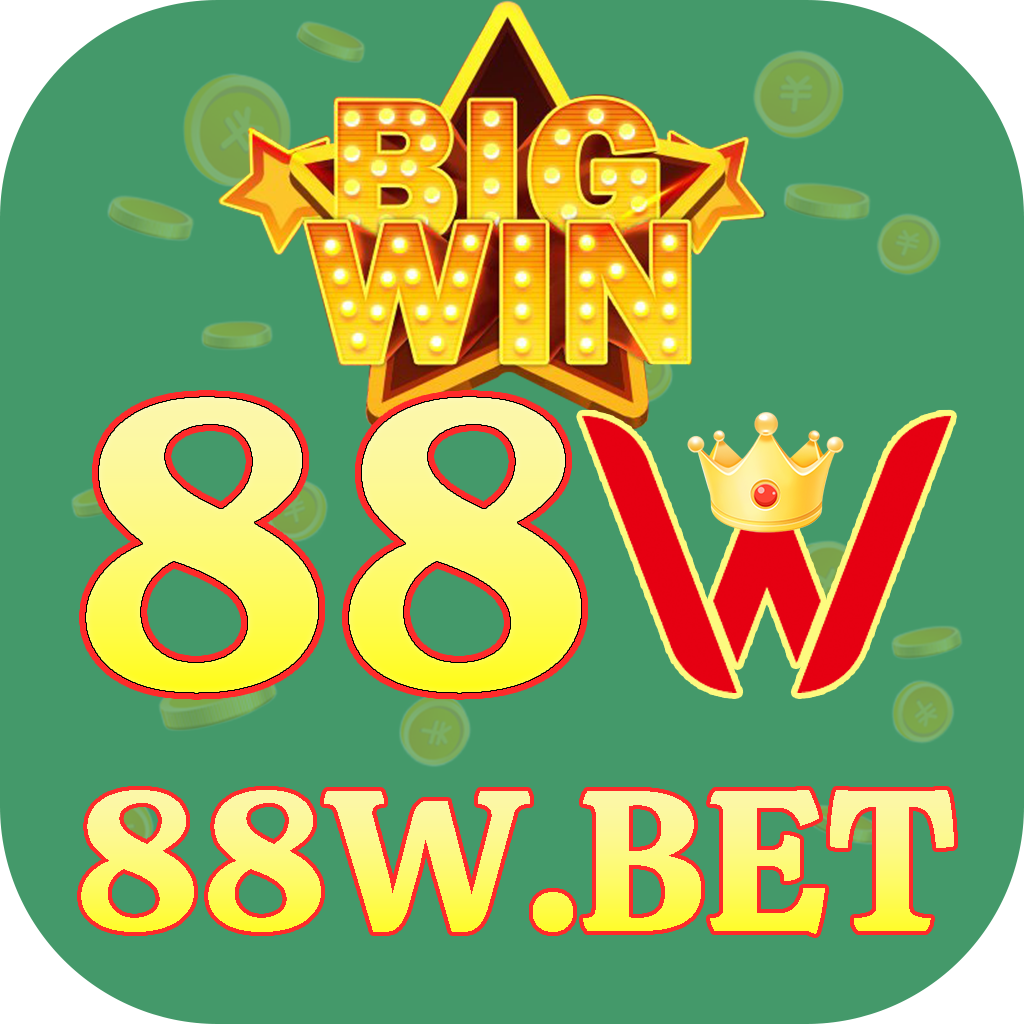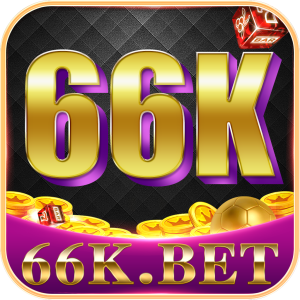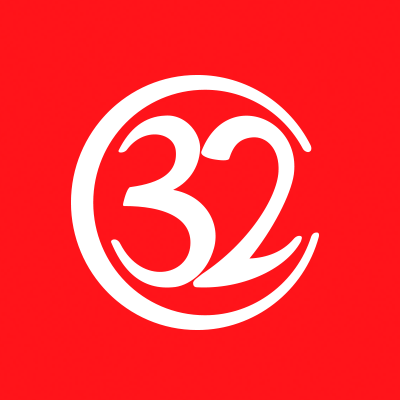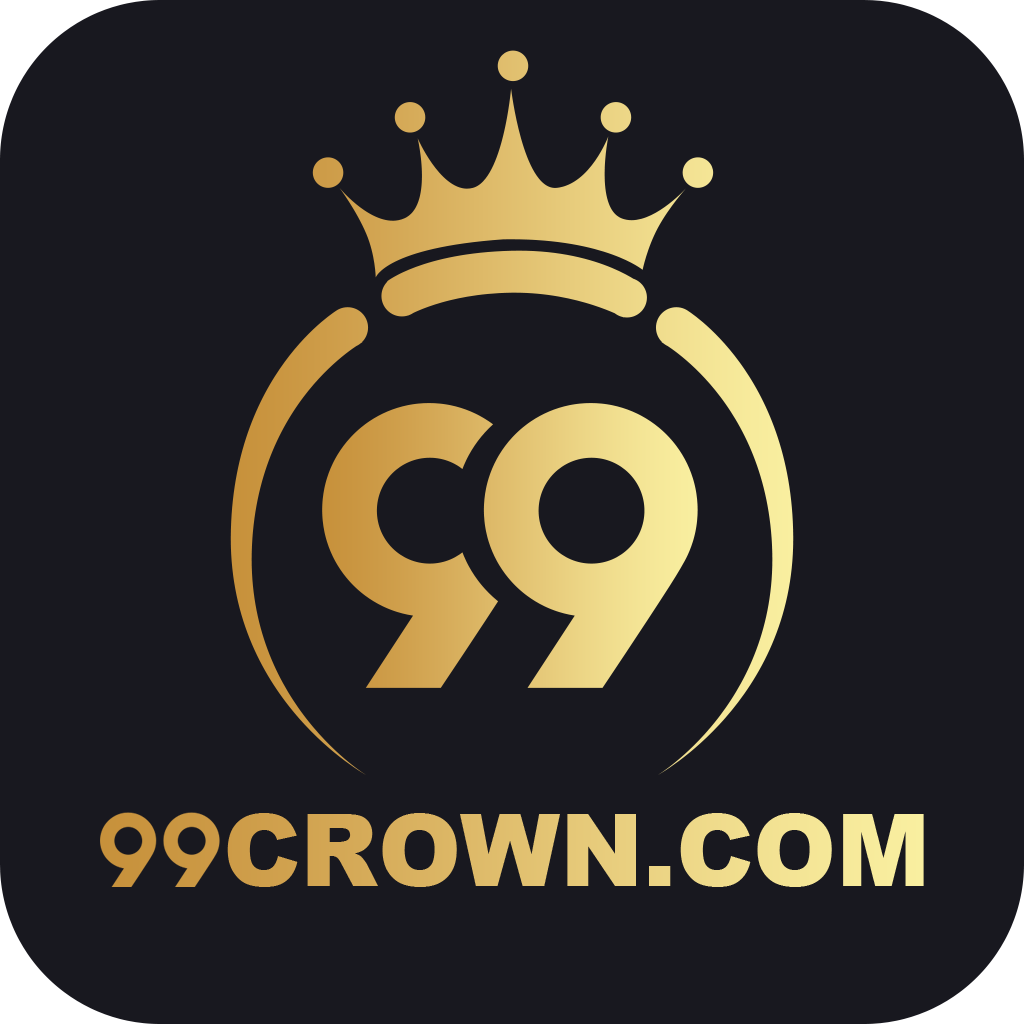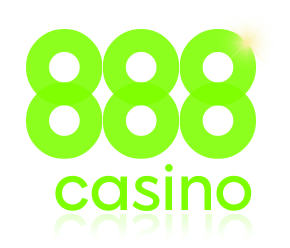purpose of blackjack
The condition for winning 21 points is that the total points of the cards in the player’s hand must be as close to 21 points as possible, but not more than 21 points. If the player’s score is closer to 21 than the dealer’s score, or if the dealer’s score exceeds 21, the player wins. However, if the player’s points are over 21, or if the dealer’s points are closer to 21 than the player’s points, the player loses.
Beat the dealer. There can be some misconceptions when playing blackjack, but at the most basic level, your goal is to beat the dealer.
How to beat the dealer?
- By taking a higher hand value than the dealer’s hand
- The total number of cards in the dealer’s hand has exceeded 21 points.
- If the dealer does not receive your first two cards, your hand will be worth 21.
How can you lose to the dealer?
- The value of the card in your hand has exceeded 21.
- At the end of each round, the dealer’s cards must be worth more than your cards.
It’s also worth noting that in blackjack, the cards in the other players’ hands are irrelevant to winning the game, as in poker. In fact, it’s just you versus the dealer. Some players new to the game might try to convince you that it’s a team sport, but don’t be fooled.
blackjack card value
When playing blackjack, a traditional 52-card deck is used and suit does not play a significant role.
- Numbers from 2 to 10 are counted according to their face value, eg 2 is considered 2 and 9 is considered 9.
- The cards of J, Q, K count as 10 points.
- The Ace can have a value of 1 or 11, depending on which value helps the hand the most.
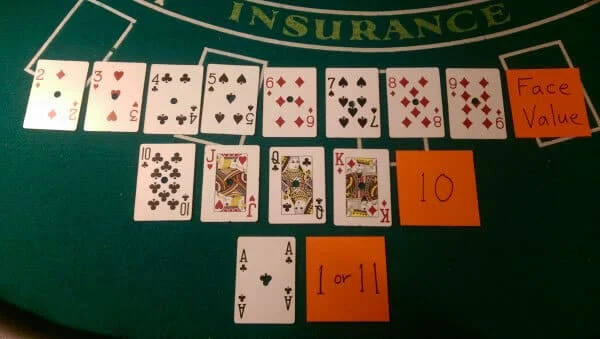
Blackjack table setup
The game of blackjack is usually played on a table that is usually semicircular and can accommodate varying numbers of players. The most common is a seven-player table, which means there are seven places for players to sit. However, we have also seen some tables with only five players or twelve places! The dealer will stand behind the table and chip rack, while the players will sit on the other side.
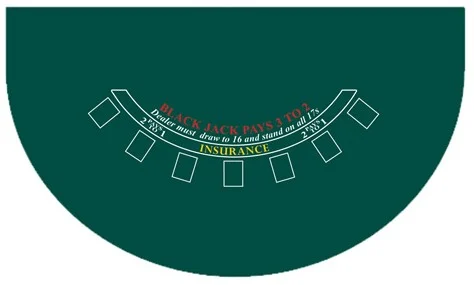
playing blackjack
Blackjack games have different rule variations and number of decks. Most commonly, cards are dealt using a “card shoe” of 6 or 8 decks. Although there are single deck and double deck games, not all casinos offer these options, so it is more common to use a shoe game. The following is the basic flow of the 6-deck blackjack game:
- Players buy gaming chips
- player bet
- The dealer distributes the cards to the players
- Players play the hand according to their own decisions.
- dealer playing cards
- expenditure
1.Players buy gaming chips
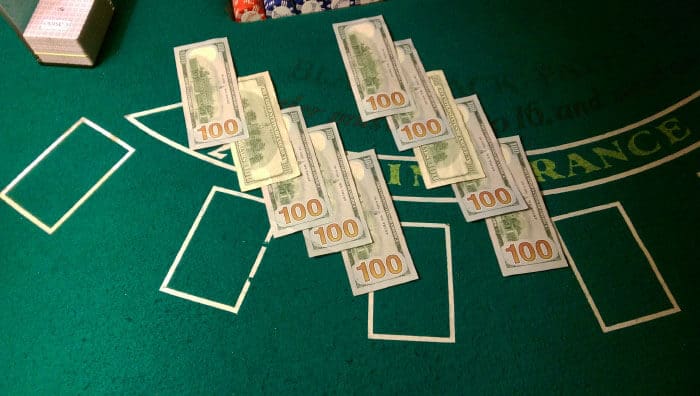
Before you go to the table, you need to prepare your chips. Most casinos these days no longer accept cash bets, so you will have to exchange your money for casino chips. Just walk up to the table and place the money on the felt on the table. Please do not pay directly to the dealer (they will not accept it). For security reasons, dealers cannot accept anything from players, and likewise, players cannot take anything from dealers directly. After you put the money on the felt, the croupier will place it on the table so that the camera can clearly capture the amount, and then the staff who will verify the amount will come to confirm. The dealer calculates the face value of the chips equal to your purchase and pushes the chips to you. Thereafter, you are free to handle your chips and place your bets. The dealer will arrange your purchase amount on the felt so that the camera can clearly capture the amount. This is how $1,000 buys chips.
2.player bet
When the game starts, the first thing you do is place your bets in the betting area. The betting area may be a square or the casino logo on the table. There will be a small sign on the far right or left of the table telling you your betting limits. In the United States, most gaming tables require a minimum bet of $5 per hand, but minimum and maximum bets may vary by casino and regulatory environment.
3.The dealer distributes the cards to the players
After you place your bet, the dealer will deal a face card clockwise to each player on the table and then a face card to himself. She then deals one more face-up card to each player, and one more face-up card to herself. Each player will have two up cards in front of them, while the dealer has one up and one down card. This is the situation shown in the figure below. Now is the time to start playing!
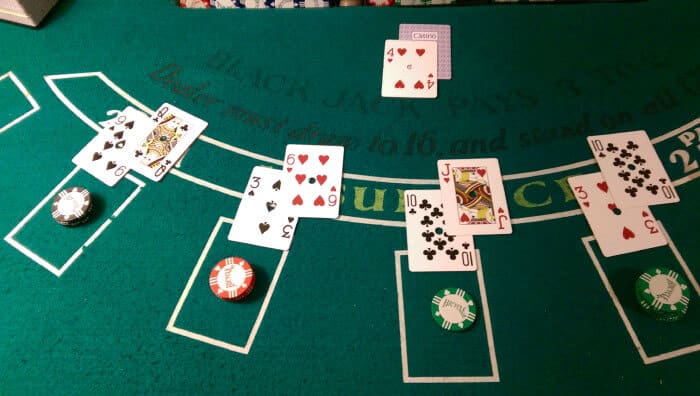
4.Players play the hand according to their own decisions.
The dealer starts with the person to their left (also known as “first base”) and waits for that player to play. You have two face up cards in front of you as your bet. To play your hand, you first need to add up the points on the board to get the total number of cards in your hand, which will be between 4 and 21 points. If your first two cards are a 10 point card and an Ace, that means you have 21 points! Congratulations! As long as the dealer doesn’t hit blackjack, you’re immediately paid 3 to 2 (or 1.5 times your bet) without continuing the round. If the dealer also has blackjack, you won’t win anything, but you won’t lose your original bet either. This situation is called “push”. If you don’t have blackjack, and the dealer doesn’t have blackjack, then the dealer continues to rotate points at each player, waiting for you to make a decision on how to play your hand. When it is your turn, you must use the correct hand gestures to indicate your decision. The dealer will not respond to your verbal instructions because the cameras need to see your decisions. You have five ways to play the cards in your hand:
Stand – If you are satisfied with your first two cards, you can choose to stand and the dealer will move on to the next player. 【Gesture: Wave your hand or simply spread your palms open on the tablecloth. 】
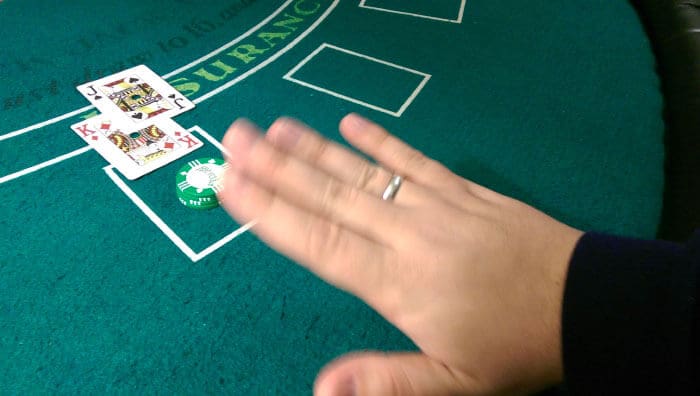
Hit – you can choose to hit the card. The dealer will deal you cards one by one until you exceed 21 (“bust”) or you choose to stop taking cards. There is no limit to the number of cards you can ask, but the total cannot exceed 21. The gesture of taking a card is to tap the tablecloth lightly with your fingers.
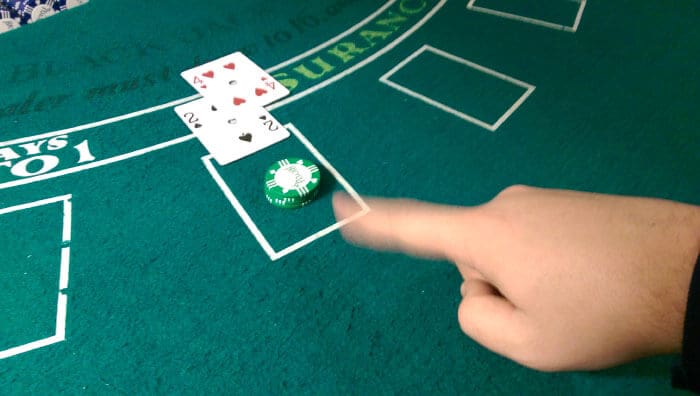
Double Down – When your hand totals in your favour, and you need to draw another card, you can double your initial bet and the dealer will only deal you an extra card. 【Gesture Tips: Just bet on the left side of the original bet, the bet amount is equal to the value of your initial bet, and the dealer will give you an extra card. Turning sideways means you can take no more cards. 】Please note: Most casinos also allow you to choose “less doubles”, which means you don’t have to bet the same amount as your original bet. However, doubling down with a lower stake is mathematically wiser in any case than doubling the full amount, so we discourage “double up with a lower stake” even if the casino allows it.
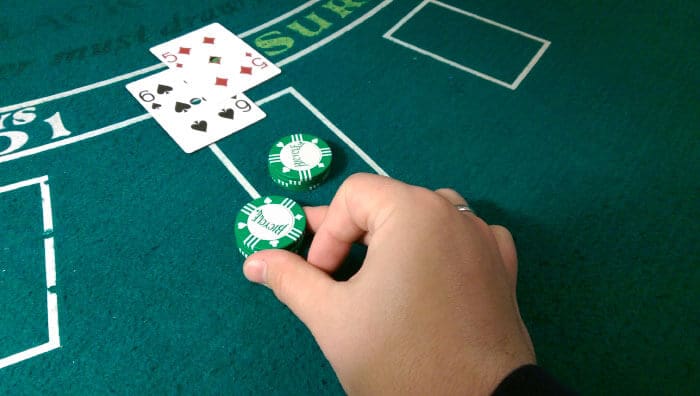
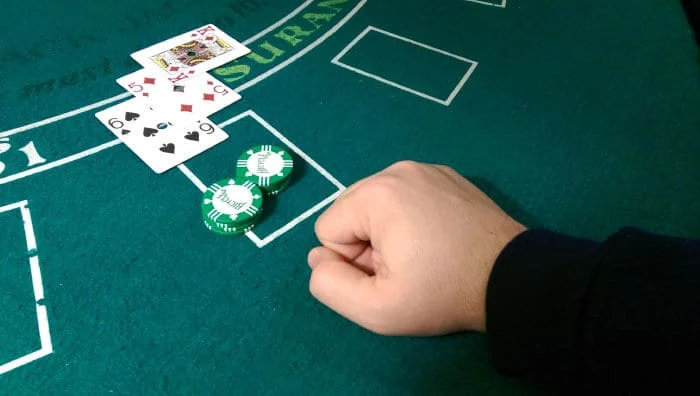
Split – If you have a pair of cards of the same value, you have the option to make another bet. The dealer will split the two cards and each card will become the first of two new decks. This rule also applies to head cards. Even though it’s not an actual pair, you can split a hand consisting of a King and a Jack because they have the same point value. 【Gesture: The amount of the second bet is the same as the first bet. Then make a “peace sign” to indicate that you want to split rather than double the bet. The dealer draws two cards from your first deck and deals you the second card of the two decks. 】
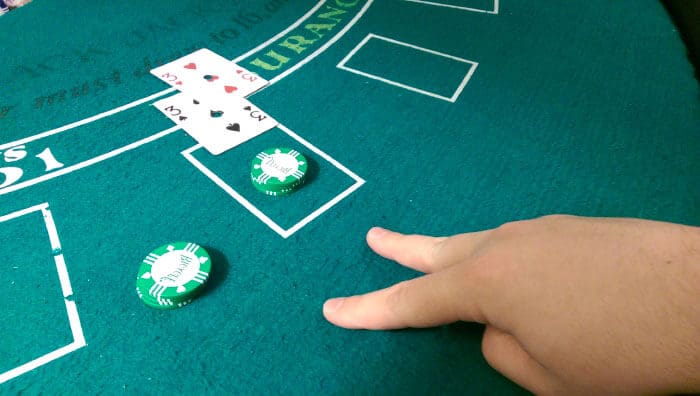
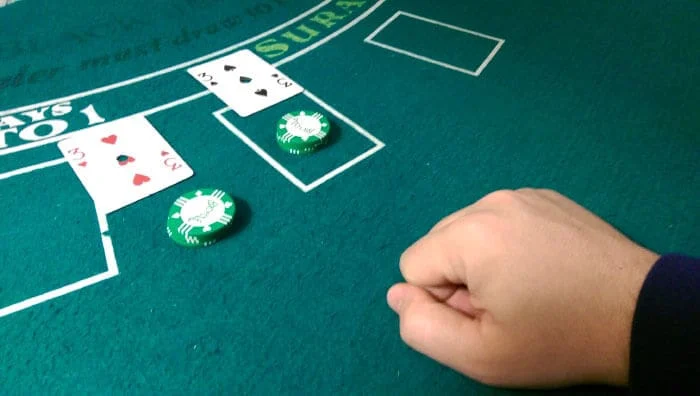
Surrender – If you don’t like your initial hand, you can choose to throw in the towel in exchange for half of your original bet. 【Gesture: Draw a line on the felt behind the stake, as if cutting a slit in the felt with an imaginary knife. Dealers often mistake this signal for a “hit” signal. Just to be on the safe side, be sure to verbally say “Give it up” to the dealer and signal it on the camera’s felt. 】
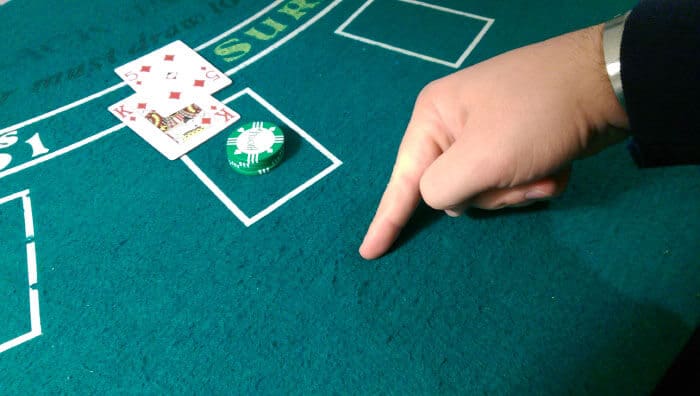
5.dealer playing cards
I understand what you’re thinking, “Gee, with so many options, how do I know which is the best?” Well, it mostly depends on the dealer’s “face up card” (ie the dealer’s card that’s visible to the player).
basic strategy
Based on what the dealer shows and the cards in your hand, you can make choices based on basic strategy. The basic strategy is the mathematically optimal way to play for each combination of the player’s hand and the dealer’s upcard. It was created by a computer playing millions of rounds of blackjack, determining the best way to play each hand combination based on what works best for the player. If you employ basic strategies, you can take the guesswork out of decision-making! Yo!
Player Hand Resolution
When you play according to the basic strategy and choose any of the options listed above, one of the following three situations will occur.
- When you are dealt a hand of cards, you should immediately stop drawing additional cards. According to the suggestion of the basic strategy, you should not continue to draw other cards.
- When you become a hand, it means that you have acquired an additional card (could be the same card, a pair of cards, or separate cards), and the total value of the cards in your hand is 21 or lower, and it does not exceed 21 points (that is, it is not busted).
- Your hole card is out – you hit your hole card one or more times and are “out”, or you choose to fold. If your card busts, you will lose your bet immediately. This is why the casino has the upper hand in the game. Players have to be the first to go, and even if the dealer ends up going broke like you, they still keep your money because you went broke first.
If your hand does not exceed 21 and you do not choose to surrender, the dealer will start playing. The dealer will first turn over their hole cards (the cards that are turned upside down), and then add up the points of the two cards in their hand. If the dealer’s hand totals 17 or more, they stop taking cards. If the dealer’s hand totals 16 or less, they continue to draw. The dealer has no options for doubling, splitting or surrendering, and they cannot choose how they play their cards like the players. The dealer must play according to fixed rules. The only exception is a 17 made up of Aces and 6s in the dealer’s hand, which is called a “soft 17”. According to the regulations of the casino, the dealer sometimes continues to ask for cards, because A can be counted as 1 point, so that the dealer has more chances to get a better card than 17 points. This gives the house a greater advantage compared to the rule that the dealer must stand on all 17-point hands. Whether or not the dealer will continue to hit until a soft 17 is usually clearly indicated in text on the table so you can see how the dealer will play. Again, the dealer has no right to violate the rules set by the casino.
6.Payouts
When you finish your hand and the dealer finishes theirs, one of two things will happen.
- The dealer will bust, the dealer must pay each player still playing the same amount as their bet on the table (ie 1 times the bet). In addition, bookmakers have the option to…
- The dealer will make a hand (between 17 and 21 in total). If you want to keep playing then it will be an easy showdown to see who has the better card. If the dealer has a higher card, he will take your bet. If you have a higher card, the dealer will pay you twice your bet. If you and the dealer have the same hand total, this is called “closing out” and you keep your money, but you do not get paid for your bet.
The current round is over! This round of victory belongs entirely to it. All the cards have been put away, now you can start a new round.
Special case
There are a couple situations where a game of Blackjack will deviate from the procedures outlined above.
Insurance/Even Money Bet: Insurance is an extra bet when the dealer reveals an ace. The dealer will provide insurance (can be in cash) before the game starts. You can bet an amount equal to half the original bet or less, and you will be paid 2 to 1 if the dealer’s down card is a 10. Simply put, you are betting on whether the dealer will have blackjack. If you win, you get paid 2 to 1. As a player of basic strategy, you should always refuse to buy insurance or even money. Only someone who knows how to count cards can skillfully play this side bet. After all players who want to buy insurance have placed their bets, the dealer will check her hidden cards (using a special viewing window on the table). If the dealer’s hidden card is a 10, she gets blackjack and takes all the players’ original bets. Everyone who buys insurance will get a 2 to 1 bonus. If the dealer’s hidden cards have no cards less than 10, she will accept all insurance bets and the game will continue. If you have blackjack and the dealer has an ace, you get a “even money”. Don’t be fooled! It’s just another name for the mathematical equivalent of insurance. If you’re betting even money, you won’t get the 3-to-2 odds you normally get on blackjack. You only get back double your original bet (even cash) regardless of whether the dealer has blackjack or not. If you do not place a bet and the dealer has blackjack, your bet will increase and your blackjack will not be paid out.
If you do not place a bet, and the dealer does not hit blackjack, you will be paid 3 to 2 according to the usual rules. Again, if you are not a professional card counter, you should not bet. To better understand the difference (or rather the difference) between insurance and money.
Non-Insurable Dealer Blackjack: It is possible for the banker to receive blackjack without providing insurance or compensation. When the dealer shows ten cards, they will automatically look at their hole cards, and then allow other players to operate. If the hole card is an A, then the dealer will have blackjack, and all bets on the table will go to the dealer, unless another player also has blackjack, then it will be a tie. Insurance can only be offered when the dealer reveals an ace.
Dead hand: is a situation in which all players blew their cards before the dealer played. At this time, the dealer will disclose her hole cards for the camera to record, and then put the cards away in the discard pile. There is no need to challenge the dealer’s hand and waste cards because the dealer has already won the other players.
Side Bets: Side bets in blackjack have grown in popularity over the past 20 years. Insurance is the only additional bet offered on all blackjack tables and is an important factor in winning a hand. However, there are many other types of side bets on gaming tables today. Most of them require you to place side bets alongside your main bet. You can bet on your first two cards pairing, betting on whether the dealer’s card will pair with yours, betting on whether your card and the dealer’s upcard make a hand, betting on whether the dealer will bust, and more. These side bets are very common and have different rules and paytables, so we won’t explain them in detail. Note that these side bets are not part of the blackjack game itself, but may interfere with the normal dealing of the cards. We do not recommend making these side bets. Casinos only offer them because they have great advantages for gamblers. So don’t be fooled, learn how to count cards.
Blackjack Rule Variations
Blackjack game play is subject to a variety of rule changes and conditions. In other words, different rules will have an effect on the odds and player favorability, so not all blackjack games are created equal. Below is an overview of some of the rules that affect game odds.
Doubling After Splitting (DAS): means that you can increase the bet amount on the card you just dealt. Some casinos allow players to double their bets after a split, while others do not. Most casinos allow this rule, which is beneficial to players.
Resplit Aces (RSA): Some casinos allow players to resplit a pair of Aces. This means that if you just split a pair of aces, and the next card is another ace, you can split again. Up to a third set of cards can be split, for a total of up to four sets of cards. Since the ace is the strongest hand, it is a very favorable rule for the player if the casino allows RSA. Generally, even if the casino offers RSA, each ace is limited to one card. After splitting the ace, you cannot increase your bet, nor can you draw any more cards. This is because the casino knows that the ace is the strongest hand, and they try to limit the situations in which the player gains an advantage.
Early Surrender: American casinos have no longer followed this fixed rule since the 70s. Same as the usual ‘drop in’ rules, you can only choose to forfeit the game until the dealer checks the blackjack or offers insurance. When this rule is still in place, it is so beneficial to the players that even without counting cards, players familiar with the basic strategy can have a slight advantage. However, it was for this very reason that it was eventually abolished. Due to the existence of early abandonment games, some perfectionists call the regular abandonment game rules “delayed abandonment games” to distinguish them.
6 to 5 Blackjacks: Some casinos offer blackjack, reducing the odds from 3 to 2 to 6 to 5. This increases the edge of the casino and makes people need to invest more money. This also makes the card counting strategy basically useless. Not every gaming table has this rule, so be sure to read the rules on the tablecloth before you sit down.
CSM Blackjack:Some casinos use sequential shufflers at blackjack tables. The machine shuffles the cards continuously as the cards are played. Instead of putting already used cards into the discard tray, the dealer feeds them directly into the machine so the shoe never runs out of cards. The purpose of this is to prevent the appearance of counting cards, and it also reduces the winning rate of basic strategy players.
Using multiple decks versus single decks: All else being equal, increasing the number of decks used increases the house’s edge in blackjack. As a rule of thumb, a six-deck game has a higher house edge than a two-deck game. The problem, though, is that other things are rarely equal. Typically, a single-deck game does not allow splitting or re-split aces and pays 6 to 5 to win blackjack; while in the same casino, an eight-deck game may allow split and re-split aces to double and pays 3 to 2 to win blackjack, so the house edge is lower. There are trade-offs when choosing rules and deck sizes.
Shoe Penetration (PEN): is the percentage of cards actually dealt out of the total number of boxes. Typically, a cut card is inserted into the shoe, with the back facing the direction it was dealt. When the number of remaining cards has just run out, it notifies the dealer that the shoe is out of cards, and the dealer reshuffles the deck and starts a new shoe. While only a quarter of a deck is enough for a round of blackjack, most casinos will cut more cards to limit card counting strategies. For card counters, the depth of penetration of the shoe can be the difference between winning or losing a game of blackjack.
blackjack game in disguise
In the United States, blackjack is a very popular game because many people try to outsmart their opponents by counting cards. Due to its popularity and well-known rules, many casinos have introduced different blackjack variations that use many of the rules and terminology of blackjack in an attempt to capitalize on blackjack’s reputation. The casino knows that they are actually creating an entirely new game, but they want to convince you that this new game is the same as blackjack so that you feel familiar and the casino has a bigger edge. Here are some blackjack quadratic rules you should avoid:
Super Fun 21: This game is generally played with a deck of cards, and you can choose to surrender any number of cards in your hand, or double any number of cards in your hand. If you have 6 cards totaling 20, or 5 cards totaling 21, you will automatically be paid out. And, players always win money! Sounds like a dream. But the only problem is that blackjack only pays the same amount (unless any card is a diamond suit). As a result of this change, the game loses the benefits of its original “super fun” rules, and the house edge is almost three times higher than regular blackjack. So this game is not really blackjack. So I suggest you stay away!
Spain 21: is a game that is popular all over the country. Although it has the same rules as the previously mentioned game, it still pays out 3 to 2 in blackjack, and you can double down (that is, double up on the same hand twice). Sounds great, right? But this is not the case! In this game, all 10s are removed from the deck (although other cards remain, but no 10s).
If you know anything about counting cards, you will understand that 10s and aces are the player’s most valuable cards. However, if you remove all 10 cards from the deck, that means you won’t be able to experience the exciting content in other rules. Moreover, Spanish 21 also has a more complex basic strategy than traditional blackjack, causing most people to be unable to play this game correctly, so it is easier to be at a disadvantage than the game content promoted by the casino. The casino is very happy with players who like to play Spanish 21. So please stay away from this game, it is not real blackjack.
Free Bet Blackjack: In this game, you can bet as if you were playing blackjack. The difference is that instead of leesn’t it look great? Indeed! In exchange for free bets, if the dealer’s card exceeds 21 and your hand totals 22, all bets will be refunded (even if the dealer busts). It’s unbelievable! In doing so, the casino increases its edge over regular blackjack games. In fact, it’s not real blackjack at all. We should stay away from it!
Blackjack Switch: is a game that is somewhat different from traditional blackjack. You’ll start with two blackjack hands, and if you think you can get a better hand combination by swapping the top cards of each hand, you can choose to do so. Some seasoned blackjack players might want to try this, so it seems like it will save both hands, right? but it is not the truth! Just like in free bet blackjack, if the dealer gets 22, the dealer wins all bets, while the player gets only the same amount for getting 21. This is not real blackjack! no thanks! There are other games masquerading as blackjack that we haven’t mentioned here since they would take too much time to introduce. Before you start, make sure you’re playing real blackjack!
